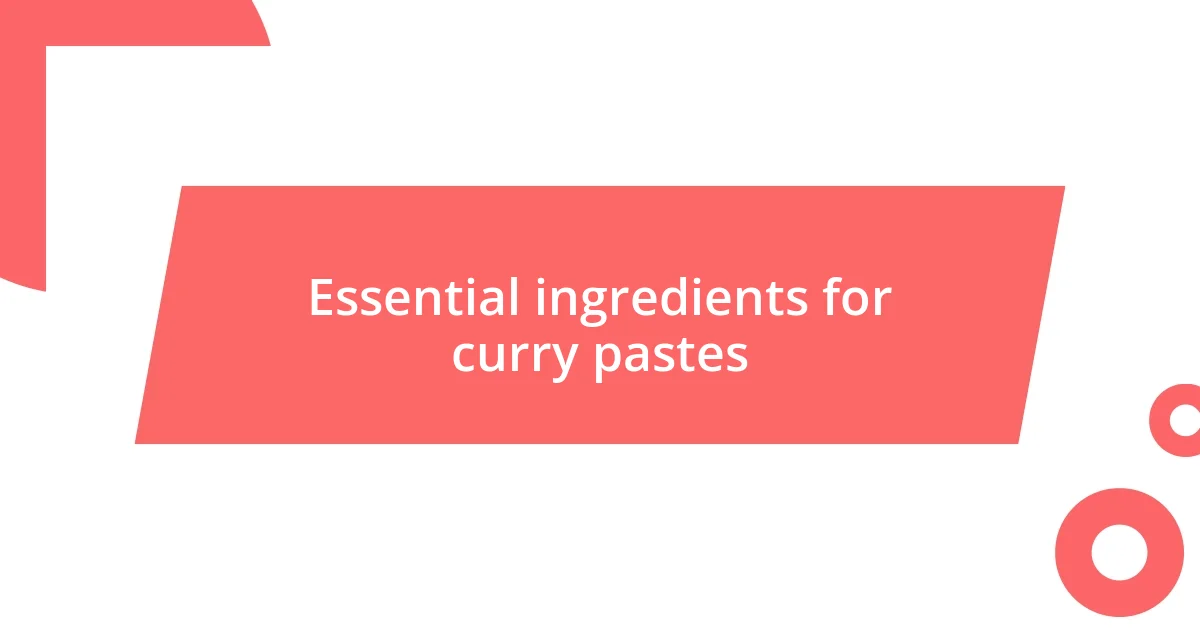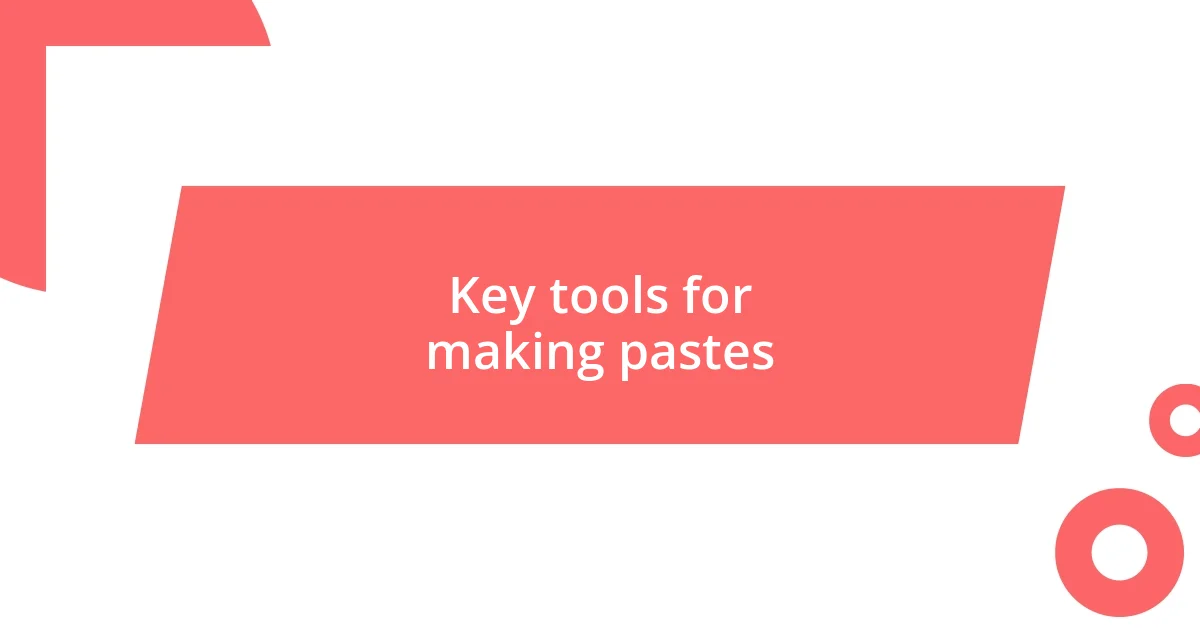Key takeaways:
- Homemade curry pastes offer freshness, customization, and the satisfaction of using organic ingredients, allowing chefs to tailor flavors and avoid preservatives.
- Key ingredients for curry pastes include garlic, ginger, cumin, coriander, and fresh herbs, while essential tools such as blenders, mortar and pestle, and glass jars streamline the process.
- Variations in curry pastes, influenced by regional ingredients and methods, can significantly enhance flavor, making cooking an adventurous and rewarding experience.

Benefits of homemade curry pastes
Making my own curry pastes has transformed the way I cook, offering a level of freshness I can’t get from store-bought options. I remember the first time I blended my spices—suddenly, the aroma of ginger and garlic filled my kitchen, igniting my senses. Isn’t it amazing how the act of simply grinding fresh ingredients can elevate an everyday meal to an aromatic masterpiece?
One of the greatest benefits I’ve found is the ability to customize flavors to suit my preferences. I can control the heat by adjusting the amount of chili or experiment with herbs like coriander and mint to match the dish I’m preparing. Have you ever made a dish where the flavors just didn’t quite align? With homemade pastes, that’s a thing of the past—each batch can be tailored to my taste, ensuring each meal is just right.
Beyond taste, I also appreciate knowing exactly what goes into my curry pastes. I feel a sense of pride in selecting fresh, organic ingredients. There’s something comforting about creating a product from scratch, especially when I know it’s free from preservatives and additives. Isn’t it reassuring to serve food that you know is made with love and care?

Essential ingredients for curry pastes
When I create my own curry pastes, the essential ingredients really set the stage for incredible flavor. My go-to ingredients usually include garlic, ginger, and a blend of spices like cumin and coriander. The first time I tossed these into my blender, I was amazed at how they came together, creating a vibrant, aromatic base that instantly made my heart race with excitement.
In addition to these staples, I often rely on fresh herbs like cilantro and Thai basil to add depth. Fresh ingredients not only heighten the taste but also contribute to the color and texture of the paste. I recall the sheer delight I felt when I made a green curry paste infused with zesty lime leaves; the brightness transformed my dish, making a lasting impression on my guests.
Finally, don’t forget about the heat! Adjusting the amount of chili peppers in the paste can create a truly personalized experience. I remember preparing a batch with a bit too much heat—my eyes were watering, but I couldn’t help but grin. It was a fun reminder that cooking involves experimentation, and each blend can be a culinary adventure of its own.
| Ingredient | Purpose |
|---|---|
| Garlic | Enhances flavor and aroma |
| Ginger | Adds warmth and a subtle spiciness |
| Cumin | Provides earthiness |
| Coriander | Offers citrusy notes |
| Chili peppers | Controls heat level |
| Cilantro | Adds freshness |
| Thai basil | Introduces a hint of sweetness and anise-like flavor |

Key tools for making pastes
When it comes to making curry pastes, having the right tools is essential. My kitchen is a treasure trove of these handy gadgets, and I’ve learned that not all tools are created equal. I remember struggling with a flimsy blender once; it just couldn’t handle the textures I wanted. Quality tools can truly elevate the process, allowing the ingredients to shine.
Here are the key tools I rely on for making my curry pastes:
- High-speed blender or food processor: This is the heart of my paste-making. It effortlessly blends all the ingredients into a smooth consistency.
- Mortar and pestle: I love the traditional approach when I want to make smaller batches. Grinding spices by hand adds a personal touch and releases oils that enhance the flavor.
- Measuring spoons and cups: Precise measurements can make or break a paste. I often play with ratios, but starting with accurate amounts helps avoid major flavor mishaps.
- Spatula: It’s not just for mixing! I use it to scrape down the sides of the blender to ensure everything is well combined.
- Glass jars: I store my pastes in these to keep them fresh. There’s something satisfying about filling a jar with my own creation, ready to spice up my next meal.
Having the right tools not only streamlines the process but also amplifies my creativity in the kitchen. I find that using quality tools turns what could be a chore into a rewarding experience.

Storage tips for curry pastes
Storing my curry pastes wisely is crucial to keeping that fresh and vibrant flavor intact. I always opt for glass jars with airtight lids, as they prevent any unpleasant odors from mingling and really seal in the goodness. Once, I tried using plastic containers, but I could taste a distinctly off flavor after a few days—an experience I won’t repeat!
I find that labeling the jars with the date of creation is a simple yet effective practice. It’s easy to forget how long something has been tucked away, and trust me, I’ve learned the hard way that curry pastes don’t last forever. Honestly, it makes me feel proud every time I pull out a jar, knowing exactly how fresh that flavor still is.
When it comes to the freezer, I often make ice cube-sized portions of my pastes. This way, I can simply pop out a cube whenever I feel like cooking up a delicious dish. Have you ever experienced the joy of knowing a flavorful meal is just a cube away? It’s like having a secret stash of gourmet goodness ready to go, always making my cooking feel effortless!

Variations of curry pastes
When it comes to curry pastes, the variations are as colorful and diverse as the cuisines they represent. Personally, I love experimenting with different flavor profiles, such as blending a rich Thai red curry paste with fresh lemongrass and kaffir lime leaves. The first time I did this, I was surprised at how those bright, aromatic notes completely transformed the dish. Have you ever tried tasting a curry before and then after adding just a hint of fresh herbs? It’s like unlocking a new level of flavor!
Another variation that I frequently return to is the Punjabi curry paste, where the warmth of spices like cumin, coriander, and garam masala takes center stage. I find that toasting these spices before blending not only enhances their flavors but also fills my kitchen with an irresistible aroma. It’s almost meditative; with each whiff, I can feel my senses waking up, eager to create something delicious. Do you have a go-to spice that you can’t resist adding to your pastes?
I’ve also discovered that regional variations can make a huge difference. For instance, I once tried making a Sri Lankan curry paste, focusing on the unique addition of roasted spices like mustard seeds and fenugreek. It was a game-changer! The complexity and depth it brought to my dishes were astonishing. Imagine diving into a bowl of curry that sings with unexpected flavors. Isn’t it incredible how one simple change in ingredients can lead to a completely different culinary experience?

Cooking with homemade curry pastes
Cooking with homemade curry pastes opens up a world of possibilities in the kitchen. I remember the first time I used my own paste in a sizzling stir-fry. The aroma wafted through my home, wrapping around me like a cozy blanket. It was astonishing how the flavors danced together, elevating a simple meal into something genuinely extraordinary. Isn’t it amazing how just a spoonful of energy-packed paste can transform everyday ingredients into a culinary masterpiece?
One of my favorite ways to incorporate homemade curry pastes is by mixing them into marinades for proteins. I vividly recall marinating chicken thighs overnight with my green curry paste. The next day, when I grilled them, the flavor was nothing short of magical. That fusion of spice seeped deep into the meat, creating a tender, flavorful bite that was the star of the dinner table. Plus, the vibrant green color was such a feast for the eyes! Have you ever had a dish that was so good it became an instant favorite?
Another delightful trick I’ve picked up is adding a spoonful of curry paste to soups and stews. The first time I did this with a simple vegetable soup, I was taken aback by the depth it added. The paste infused the broth with rich flavors that perfectly complemented the fresh veggies. It made me wonder why I hadn’t tried this sooner! Have you discovered any unexpected ways to use your own curry pastes? Each experience is not just about cooking; it’s like a flavorful adventure waiting to happen!















